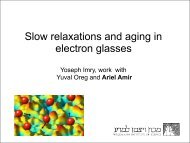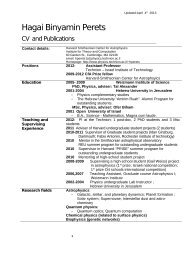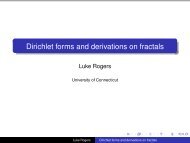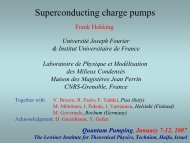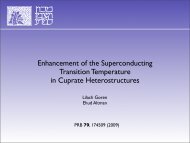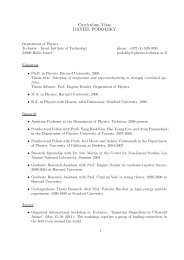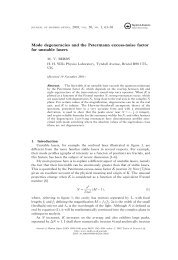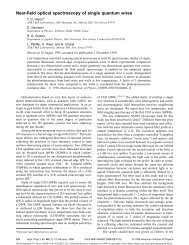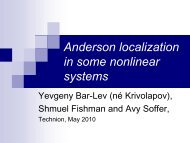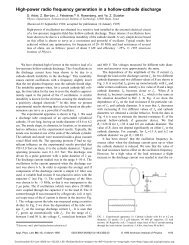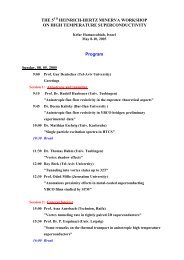Long range triplet SC in LCMO/YBCO bilayers - Physics@Technion
Long range triplet SC in LCMO/YBCO bilayers - Physics@Technion
Long range triplet SC in LCMO/YBCO bilayers - Physics@Technion
You also want an ePaper? Increase the reach of your titles
YUMPU automatically turns print PDFs into web optimized ePapers that Google loves.
YOAV KALCHEIM, TAL KIRZHNER, GAD KOREN, AND ODED MILLO PHYSICAL REVIEW B 83, 064510 (2011)<br />
preparation process, and film thickness), which is much<br />
larger than ξS <strong>in</strong> <strong>YBCO</strong>, and thus the CARE process should<br />
be largely suppressed. Surpris<strong>in</strong>gly, our tunnel<strong>in</strong>g spectra<br />
revealed spectroscopic features conform<strong>in</strong>g to proximity<strong>in</strong>duced<br />
superconductivity even on <strong>LCMO</strong> layers as thick<br />
as 30 nm, an order of magnitude larger than the FFLO<br />
predicted ξF . Moreover, these features were not conf<strong>in</strong>ed only<br />
to narrow strips (as <strong>in</strong> our previous study 13 of SRO/<strong>YBCO</strong><br />
<strong>bilayers</strong>) and both gaps and zero-bias conductance peaks<br />
(ZBCP) were measured. Our data thus suggest, after rul<strong>in</strong>g<br />
out the CARE mechanism, that proximity-<strong>in</strong>duced <strong>triplet</strong><br />
pair<strong>in</strong>g <strong>in</strong> the <strong>LCMO</strong> layer plays an important role <strong>in</strong> the<br />
PE observed <strong>in</strong> our samples. In a recent experiment, evidence<br />
for proximity-<strong>in</strong>duced <strong>triplet</strong> pair<strong>in</strong>g at the <strong>SC</strong> side of F/<strong>SC</strong><br />
(In/Co or In/Ni) junctions was provided. 19 In this work, on<br />
the other hand, the proximity-<strong>in</strong>duced <strong>triplet</strong> correlations are<br />
found on the F side.<br />
II. EXPERIMENT<br />
We have studied epitaxial <strong>bilayers</strong> consist<strong>in</strong>g of <strong>LCMO</strong><br />
films deposited on optimally doped a-axis (100)<strong>YBCO</strong> films<br />
grown by laser ablation deposition on (100)SrTiO3 (STO)<br />
substrates. The <strong>YBCO</strong> was deposited on the STO wafer <strong>in</strong><br />
two steps. First, a 45-nm-thick template layer of <strong>YBCO</strong> was<br />
deposited at a wafer temperature of 600 ◦ C. Then, a second<br />
90-nm-thick <strong>YBCO</strong> layer was prepared at 750 ◦ C. The surface<br />
area of the <strong>YBCO</strong> consisted of 95% (100)<strong>YBCO</strong> (verified by<br />
x-ray diffraction) with no traces of (110) orientation found.<br />
The <strong>LCMO</strong> layers were grown on top of the <strong>YBCO</strong> at 790 ◦ C<br />
and annealed for one hour at 450 ◦ C <strong>in</strong> 0.5 Atm oxygen<br />
environment. The whole process was performed <strong>in</strong> situ without<br />
break<strong>in</strong>g the vacuum, and given the good lattice match<strong>in</strong>g<br />
between <strong>YBCO</strong> and <strong>LCMO</strong>, high <strong>in</strong>terface transparency could<br />
be obta<strong>in</strong>ed, which is important for the AR process to take<br />
place. The thickness of our <strong>LCMO</strong> layers <strong>range</strong>d between 15<br />
to 50 nm with surface roughness of ∼1 nmontopofthe<br />
<strong>YBCO</strong> crystallites. Full coverage of the <strong>YBCO</strong> by <strong>LCMO</strong><br />
was confirmed by x-ray photoelectron spectroscopy (XPS)<br />
and time-of-flight secondary ion mass spectrometry measurements.<br />
Magnetoresistance and resistance versus temperature<br />
measurements of the samples reveal a ferromagnetic transition<br />
of the <strong>LCMO</strong> layer at ∼250 K and the <strong>SC</strong> transition of <strong>YBCO</strong><br />
at ∼88 K, as presented <strong>in</strong> Fig. 1. It is important to note that<br />
a-axis <strong>YBCO</strong> films were chosen for this study, rather than<br />
the more common c-axis (001)<strong>YBCO</strong> films, s<strong>in</strong>ce the PE is<br />
significantly suppressed along the c axis. 20,21<br />
Samples were transferred <strong>in</strong> dry atmosphere to our cryogenic<br />
STM after be<strong>in</strong>g exposed to ambient air for less than 10<br />
m<strong>in</strong>utes. After evacuation, the STM chamber was filled with<br />
He exchange gas at 1 Torr and then cooled down to 4.2 K,<br />
where all the measurements presented here were performed<br />
us<strong>in</strong>g a Pt-Ir tip. Several control measurements were performed<br />
at temperatures up to 150 K to verify that the spectroscopic<br />
features associated with <strong>SC</strong> (gaps and ZBCPs) <strong>in</strong>deed vanish<br />
above the Tc of <strong>YBCO</strong>. Topographic images were taken <strong>in</strong> the<br />
standard constant current mode with bias voltages ∼100 mV,<br />
well above the <strong>SC</strong> gap. The tunnel<strong>in</strong>g dI/dV versus V spectra,<br />
which are proportional to the local density of states (DOS),<br />
064510-2<br />
MR (Ohm)<br />
R (Ohm)<br />
0.4<br />
0.0<br />
-0.4<br />
-0.8<br />
-1.2<br />
70<br />
60<br />
50<br />
40<br />
30<br />
20<br />
10<br />
0<br />
120 160 200 240 280<br />
T (K)<br />
0 50 100 150 200 250 300<br />
T (K)<br />
FIG. 1. (Color onl<strong>in</strong>e) (a) Magnetoresistance R(2T )-R(0) measurement<br />
of a 20-nm <strong>LCMO</strong>/(100)<strong>YBCO</strong> bilayer as a function<br />
of temperature show<strong>in</strong>g the ferromagnetic transition at ∼250 K.<br />
The <strong>in</strong>set shows the structure of our samples, the direction of the<br />
magnetic field applied <strong>in</strong> the magnetoresistance measurement, and the<br />
tunnel<strong>in</strong>g direction <strong>in</strong> the STM measurements (performed at H = 0).<br />
(b) Resistance vs temperature curve of the same <strong>LCMO</strong>/<strong>YBCO</strong><br />
bilayer depict<strong>in</strong>g a superconduct<strong>in</strong>g transition at ∼88 K. The <strong>LCMO</strong><br />
ferromagnetic transition is also manifested here <strong>in</strong> the slope change<br />
at ∼250 K.<br />
were numerically derived from the I-V curves acquired on<br />
the <strong>LCMO</strong> surface while momentarily disconnect<strong>in</strong>g the STM<br />
feedback loop.<br />
III. RESULTS<br />
Tunnel<strong>in</strong>g dI/dV versus V curves represent<strong>in</strong>g the most<br />
typical spectroscopic features found on our samples are<br />
portrayed <strong>in</strong> Fig. 2. Figures 2(a) and 2(b) do not show<br />
any <strong>SC</strong>-like features. Figure 2(a) exhibits a nearly constant<br />
metalliclike DOS, while Fig. 2(b) exhibits a wide <strong>in</strong>sulatorlike<br />
gap structure. These spectra are very similar to those reported<br />
<strong>in</strong> Ref. 22, correspond<strong>in</strong>g to conductive and <strong>in</strong>sulat<strong>in</strong>g regions,<br />
respectively, coexist<strong>in</strong>g <strong>in</strong> <strong>LCMO</strong> films. Regions exhibit<strong>in</strong>g<br />
such features were found on all our samples, with abundance<br />
that grew with <strong>in</strong>creas<strong>in</strong>g <strong>LCMO</strong> thickness. However, <strong>in</strong> many



